Social Sciences > NCLEX > Test Pediatric Growth and Development: NCLEX Questions and Answers (All)
Test Pediatric Growth and Development: NCLEX Questions and Answers
Document Content and Description Below
The nurse is aware that the age at which the posterior fontanelle closes is _____ months. a. 2 to 3 b. 3 to 6 c. 6 to 9 d. 9 to 12 - ANSWER ANS: A The posterior fontanelle closes between 2 and... 3 months of age. Which stage of development is most unstable and challenging regarding development of personal identity? A) Adolescence B) Toddler hood C) Childhood D) Infancy - ANSWER A) Adolescence A maternity nurse is providing instruction to a new mother regarding the psychosocial development of the newborn infant. Using Erikson's psychosocial development theory, the nurse would instruct the mother to A) Allow the newborn infant to signal a need B) Anticipate all of the needs of the newborn infant C) Avoid the newborn infant during the first 10 minutes of crying D) Attend to the newborn infant immediately when crying - ANSWER A) Allow the newborn infant to signal a need. Trust vs Mistrust stage-This will allow the infant opportunity to gain trust. A mother of a 3-year-old tells a clinic nurse that the child is rebelling constantly and having temper tantrums. The nurse most appropriately tells the mother to: A) Punish the child every time the child says "no", to change the behavior B) Allow the behavior because this is normal at this age period C) Set limits on the child's behavior D) Ignore the child when this behavior occurs - ANSWER C) Set limits on the child's behavior-According to Erikson, the child focuses on independence between ages 1 and 3 years. Gaining independence often means that the child has to rebel against the parents' wishes. Saying things like "no" or "mine" and having temper tantrums are common during this period of development. Being consistent and setting limits on the child's behavior are the necessary elements. A nurse is evaluating the developmental level of a 2-year-old. Which of the following does the nurse expect to observe in this child? A) Uses a fork to eat B) Uses a cup to drink C) Uses a knife for cutting food D) Pours own milk into a cup - ANSWER B. By age 2 years, the child can use a cup and can use a spoon correctly but with some spilling. By ages 3 to 4, the child begins to use a fork. By the end of the preschool period, the child should be able to pour milk into a cup and begin to use a knife for cutting. A clinic nurse assesses the communication patterns of a 5-month-old infant. The nurse determines that the infant is demonstrating the highest level of developmental achievement expected if the infant: A) Uses simple words such as "mama" B) Uses monosyllabic babbling C) Links syllables together D) Coos when comforted - ANSWER B. Using monosyllabic babbling occurs between 3 and 6 months of age. Using simple words such as "mama" occurs between 9 and 12 months. Linking syllables together when communicating occurs between 6 and 9 months. Cooing begins at birth and continues until 2 months. A nurse is preparing to care for a 5-year-old who has been placed in traction following a fracture of the femur. The nurse plans care, knowing that which of the following is the most appropriate activity for this child? A) Large picture books B) A radio C) Crayons and coloring book D) A sports video - ANSWER C. In the preschooler, play is simple and imaginative and includes activities such as crayons and coloring books, puppets, felt and magnetic boards, and Play-Doh. Large picture books are most appropriate for the infant. A radio and a sports video are most appropriate for the adolescent. A 16-year-old is admitted to the hospital for acute appendicitis, and an appendectomy is performed. Which of the following nursing interventions is most appropriate to facilitate normal growth and development? A) Allow the family to bring in the child's favorite computer games B) Encourage the parents to room-in with the child C) Encourage the child to rest and read D) Allow the child to participate in activities with other individuals in the same age group when the condition permits - ANSWER D. Adolescents often are not sure whether they want their parents with them when they are hospitalized. Because of the importance of the peer group, separation from friends is a source of anxiety. Ideally, the members of the peer group will support their ill friend. Options a, b, and c isolate the child from the peer group. The mother of a toddler asks a nurse when it is safe to place the car safety seat in a face-forward position. The best nursing response is which of the following? A) When the toddler weighs 20 lbs B) The seat should not be placed in a face-forward position unless there are safety locks in the car C) The seat should never be place in a face-forward position because the risk of the child unbuckling the harness D) When the weight of the toddler is greater than 40 lbs - ANSWER A. The transition point for switching to the forward facing position is defined by the manufacturer of the convertible car safety seat but is generally at a body weight of 9 kg or 20 lb and 1 year of age. Convertible car safety seats are used until the child weighs at least 40 lb. Options b, c, and d are incorrect A mother calls the pediatrician's office because her infant is "colicky." The helpful measure the nurse would suggest to the parent is to: a. sing songs to the infant in a soft voice. b. place the infant in a well-lit room. c. walk around and massage the infant's back. d. rock the fussy infant slowly and gently. - ANSWER ANS: D One technique the nurse can offer parents of a fussy infant is to rock the infant gently and slowly while being careful to avoid sudden movements. The nurse teaches parents how to help their children learn impulse control and cooperative behaviors. This would occur during which of the stages of development defined by Erikson? A.Trust versus mistrust B.Initiative versus guilt C.Industry versus inferiority D.Autonomy vs. Shame and doubt - ANSWER B) Initiative vs Guilt. The stage of initiative versus guilt occurs from ages 3 to 6 years, during which children develop direction and purpose. Teaching impulse control and cooperative behaviors during this stage help the child to avoid risks of altered growth and development. In the autonomy versus sense of shame and doubt stage, toddlers learn to achieve self-control and willpower. Trust versus mistrust is the first stage, during which children develop faith and optimism. During the industry versus inferiority stage, children develop a sense of competency. The nurse knows that an infant's birth weight should be tripled by: a. 9 months. b. 1 year. c. 18 months. d. 2 years. - ANSWER ANS: B The infant usually triples his or her birth weight by about 12 months of age. The nurse is aware that the earliest age at which an infant is able to sit steadily alone is _____ months. a. 4 b. 5 c. 8 d. 15 - ANSWER ANS: C The infant can sit alone without support at about 8 months of age. The nurse is aware that the earliest age at which the infant should be able to walk independently is _____ months. a. 8 to 10 b. 12 to 15 c. 15 to 18 d. 18 to 21 - ANSWER ANS: B For the majority of children, the milestone of walking alone is achieved between 12 and 15 months. The parent of a 3-month-old infant asks the nurse, "At what age do infants usually begin drinking from a cup?" The nurse would reply: a. 5 months. b. 9 months. c. 1 year. d. 2 years. - ANSWER ANS: A The infant can usually drink from a cup when it is offered at about 5 months. The nurse would expect a 4-month-old to be able to: a. hold a cup. b. stand with assistance. c. lift head and shoulders. d. sit with back straight. - ANSWER ANS: C Because development is cephalocaudal, of these choices, lifting the head and shoulders is the one that the infant learns to do first. The infant can usually sit with support at about 5 months of age and can sit alone at about 8 months. The abnormal finding in an evaluation of growth and development for a 6-month-old infant would be: a. weight gain of 4 to 7 ounces per week. b. length increase of 1 inch in 2 months. c. head lag present. d. can sit alone for a few seconds. - ANSWER ANS: C The infant should be holding the head up well by 5 months of age. If head lag is present at 6 months, the child should undergo further evaluation. A parent brings a 6-month-old infant to the pediatric clinic for her well-baby examination. Her birth weight was 8 pounds, 2 ounces. The nurse weighing the infant today would expect her weight to be at least _____ pounds. a. 12 b. 16 c. 20 d. 24 - ANSWER ANS: B Birth weight is usually doubled by 6 months of age. The nurse would advise a parent when introducing solid foods to: a. begin with one tablespoon of food. b. mix foods together. c. eliminate a refused food from the diet. d. introduce each new food 4 to 7 days apart. - ANSWER ANS: D Only one new food is offered in a 4- to 7-day period to determine tolerance. When assessing development in a 9-month-old infant, the nurse would expect to observe the infant: a. speaking in 2-word sentences. b. grasping objects with palmar grasp. c. creeping along the floor. d. beginning to use a spoon rather sloppily. - ANSWER ANS: C The 9-month-old tries to creep, has developed pincer movement, and can grasp a spoon without keeping food on it. The statement made by a parent that indicates correct understanding of infant feeding is: a. "I've been mixing rice cereal and formula in the baby's bottle." b. "I switched the baby to low-fat milk at 9 months." c. "The baby really likes little pieces of chocolate." d. "I give the baby any new foods before he takes his bottle." - ANSWER ANS: D New solid foods should be introduced before formula or breast milk to encourage the infant to try new foods. The nurse would advise a mother who is concerned because her 10-month-old is lethargic to__________. - ANSWER Go to the Emergency Department The nurse discusses child-proofing the home for safety with the mother of a 9-month-old. The statement made by the mother that indicates an unsafe behavior is: a. "I put covers on all of the electrical outlets." b. "In the car, she rides in a front-facing car seat." c. "There are locks on all of the cabinets in the house." d. "I have a gate at the top and bottom of the stairs." - ANSWER ANS: B A rear-facing infant car seat should be used for infants younger than 1 year of age. The nurse observes a 10-month-old infant using her index finger and thumb to pick up pieces of cereal. This behavior is evidence that the infant has developed: a. the pincer grasp. b. a grasp reflex. c. prehension ability. d. the parachute reflex. - ANSWER ANS: A By 1 year, the pincer-grasp coordination of index finger and thumb is well established. The most appropriate activity to recommend to parents to promote sensorimotor stimulation for a 1-year-old would be to: a. ride a tricycle. b. spend time in an infant swing. c. play with push-pull toys. d. read large picture books. - ANSWER ANS: C Push-pull toys are appropriate to promote sensorimotor stimulation for a 1-year-old child. The nurse explains that by the age of 6 months an iron-rich formula should be offered because the infant has: a. limited ability to produce red blood cells. b. ineffective digestive enzymes. c. exhausted maternal iron stores. d. need of the iron to support dentition. - ANSWER C The nurse cautions that children who have unmet hunger needs will likely display which characteristic(s)? Select all that apply. a. Irritability b. Ineffective feeding patterns c. No predictable sleep-wake cycle d. Distrust e. Effective parent bonding - ANSWER ANS: A, B, C, D Children who experience frequent hunger do not have effective parental bonding. All other options are probable outcomes for a child who has unmet hunger needs. What should the teaching plan include about infant fall precautions? Select all that apply. a. Remove all unsteady furniture. b. Keep crib rails up and in locked position. c. Steady infant with hand when on changing table. d. Use tray attachment on high chair as restraint. e. Keep infant seat on the floor. - ANSWER ANS: A, B, C, E The tray attachment to a high chair is an inadequate restraint. All other options are good precautions to prevent an infant from a fall. The nurse explains that the second process of self-mobility an infant learns is seen at the age of 9 months, when the infant begins to ___________. - ANSWER ANS: creep At 7 months the infant begins to crawl, using arms and dragging trunk and legs. At 9 months the infant begins to creep, holding his or her trunk above the floor. The next self-mobility activity is cruising, where the child walks from one piece of furniture to the next before it begins to walk independently. A 3-month-old infant, born at 38 weeks of gestation, will hold a rattle if it is put in her hands, but she will not voluntarily grasp it. The nurse should interpret this as: a. Normal development. b. Significant developmental lag. c. Slightly delayed development caused by prematurity. d. Suggestive of a neurologic disorder such as cerebral palsy. - ANSWER ANS: A This indicates normal development. Reflexive grasping occurs during the first 2 to 3 months and then gradually becomes voluntary. No evidence of neurologic dysfunction is present. In terms of fine motor development, the infant of 7 months should be able to: a. Transfer objects from one hand to the other. b. Use thumb and index finger in crude pincer grasp. c. Hold crayon and make a mark on paper. d. Release cubes into a cup. - ANSWER ANS: A By age 7 months infants can transfer objects from one hand to the other, crossing the midline. The crude pincer grasp is apparent at about age 9 months. The child can scribble spontaneously at age 15 months. At age 12 months the child can release cubes into a cup. In terms of gross motor development, what would the nurse expect a 5-month-old infant to do? a. Roll from abdomen to back. b. Roll from back to abdomen. c. Sit erect without support. d. Move from prone to sitting position. - ANSWER ANS: A Rolling from abdomen to back is developmentally appropriate for a 5-month-old infant. The ability to roll from back to abdomen usually occurs at 6 months old. Sitting erect without support is a developmental milestone usually achieved by 8 months. The 10-month-old infant can usually move from a prone to a sitting position. Most infants begin to fear strangers at age: a. 2 months c. 6 months b. 4 months d. 12 months - ANSWER ANS: C Between ages 6 and 8 months fear of strangers and stranger anxiety become prominent and are related to the infant's ability to discriminate between familiar and nonfamiliar people. At age 2 months infants are just beginning to respond differentially to the mother. At age 4 months the infant is beginning the process of separation individuation when the infant begins to recognize self and mother as separate beings. Twelve months is too late and requires referral for evaluation if the child does not fear strangers at this age. In terms of gross motor development, what would the nurse expect a 5-month-old infant to do? Choose all that apply. a. Roll from abdomen to back b. Put feet in mouth when supine c. Roll from back to abdomen d. Sit erect without support e. Move from prone to sitting position f. Adjust posture to reach an object - ANSWER ANS: A, B Rolling from abdomen to back and placing the feet in the mouth when supine are developmentally appropriate for a 5-month-old infant. A parent of an 18-month-old boy tells the nurse that he says "no" to everything and has rapid mood swings. If he is scolded, he shows anger and then immediately wants to be held. The nurse's best interpretation of this behavior is that: a. This is normal behavior for his age. b. This is unusual behavior for his age. c. He is not effectively coping with stress. d. He is showing he needs more attention. - ANSWER ANS: A Toddlers use distinct behaviors in the quest for autonomy. They express their will with continued negativity and the use of the word "no." Children at this age also have rapid mood swings. The nurse should reassure the parents that their child is engaged in expected behavior for an 18-month-old. A 17-month-old child would be expected to be in what stage according to Piaget? a. Trust b. Preoperations c. Secondary circular reaction d. Tertiary circular reaction - ANSWER ANS: D The 17-month-old is in the fifth stage of the sensorimotor phase: tertiary circular reactions. The child uses active experimentation to achieve previously unattainable goals. Trust is Erikson's first stage. Preoperations is the stage of cognitive development usually present in older toddlers and preschoolers. Secondary circular reactions last from about ages 4 to 8 months. What describes a toddler's cognitive development at age 20 months? a. Searches for an object only if he or she sees it being hidden b. Realizes that "out of sight" is not out of reach c. Puts objects into a container but cannot take them out d. Understands the passage of time such as "just a minute" and "in an hour" - ANSWER ANS: B At this age the child is in the final sensorimotor stage. Children will now search for an object in several potential places, even though they saw only the original hiding place. Children have a more developed sense of objective permanence. They will search for objects even if they have not seen them hidden. Putting an object in a container but being able to take it out indicates tertiary circular reactions. An embryonic sense of time exists, although the children may behave appropriately to time-oriented phrases; their sense of timing is exaggerated. Although a 14-month-old girl received a shock from an electrical outlet recently, her parents find her about to place a paper clip in another outlet. The best interpretation of this behavior is: a. Her cognitive development is delayed. b. This is typical behavior because toddlers are not very developed. c. This is typical behavior because of inability to transfer knowledge to new situations. d. This is not typical behavior because toddlers should know better than to repeat an act that caused pain. - ANSWER ANS: C During the tertiary circular reactions stage, children have only a rudimentary sense of the classification of objects. The appearance of an object denotes its function for these children. The slot of an outlet is for putting things into. Her cognitive development is appropriate for her age and represents typical behavior for a toddler. Only some awareness exists of a causal relation between events. Which statement is correct about toilet training? a. Bladder training is usually accomplished before bowel training. b. Wanting to please the parent helps motivate the child to use the toilet. c. Watching older siblings use the toilet confuses the child. d. Children must be forced to sit on the toilet when first learning. - ANSWER ANS: B Voluntary control of the anal and urethral sphincters is achieved sometime after the child is walking. The child must be able to recognize the urge to let go and to hold on. The child must want to please the parent by holding on rather than pleasing self by letting go. Bowel training precedes bladder training. Watching older siblings provides role modeling and facilitates imitation for the toddler. The child should be introduced to the potty chair or toilet in a nonthreatening manner. Which characteristic best describes the gross motor skills of a 24-month-old child? a. Skips b. Rides tricycle c. Broad jumps d. Walks up and down stairs - ANSWER ANS: D The 24-month-old child can go up and down stairs alone with two feet on each step. Skipping and the ability to broad jump are skills acquired at age 3. Tricycle riding is achieved at age 4. The parents of a 2-year-old tell the nurse that they are concerned because the toddler has started to use "baby talk" since the arrival of their new baby. The nurse should recommend that the parents: [Show More]
Last updated: 10 months ago
Preview 1 out of 19 pages
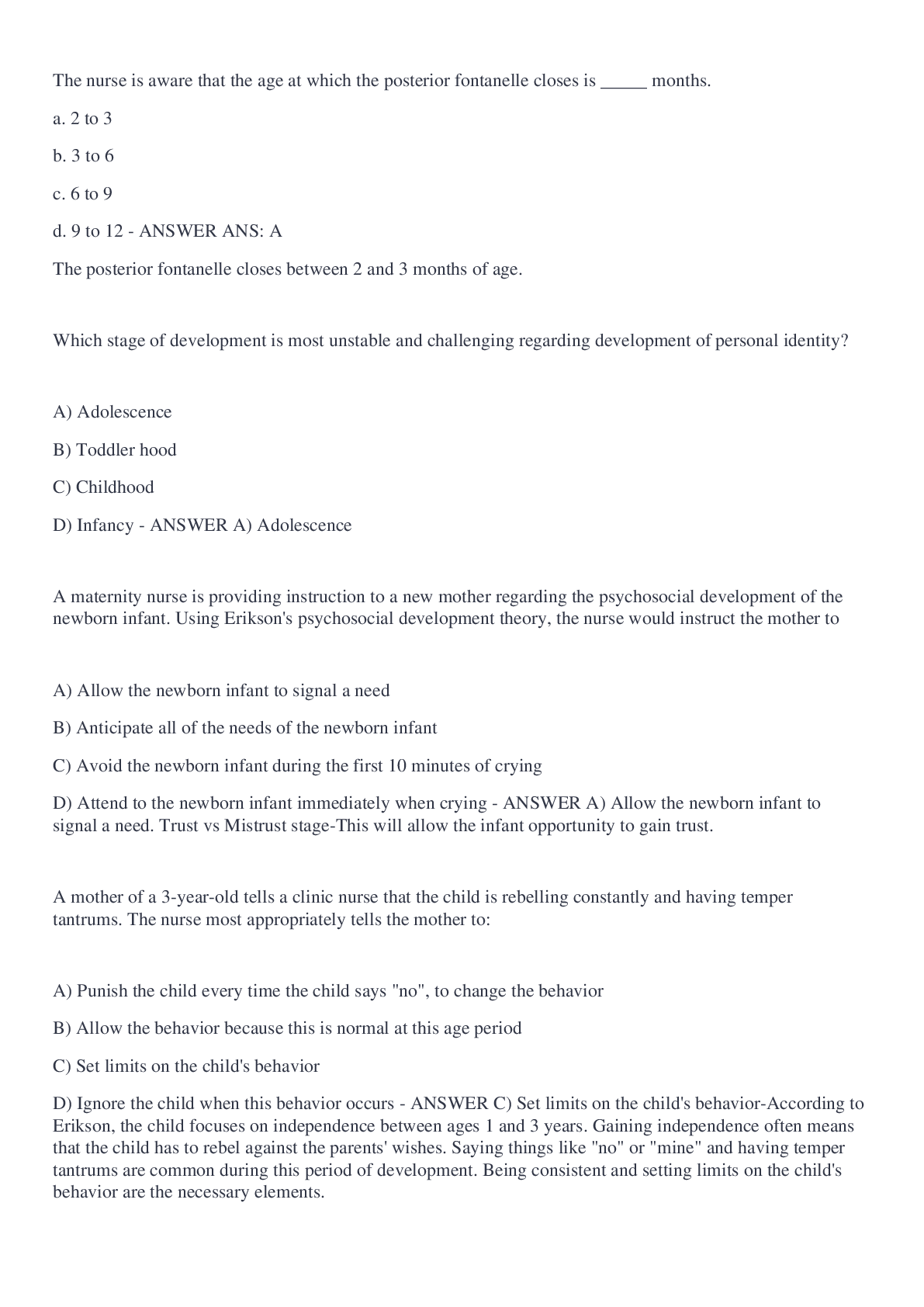
Reviews( 0 )
Document information
Connected school, study & course
About the document
Uploaded On
Aug 04, 2022
Number of pages
19
Written in
Additional information
This document has been written for:
Uploaded
Aug 04, 2022
Downloads
0
Views
90

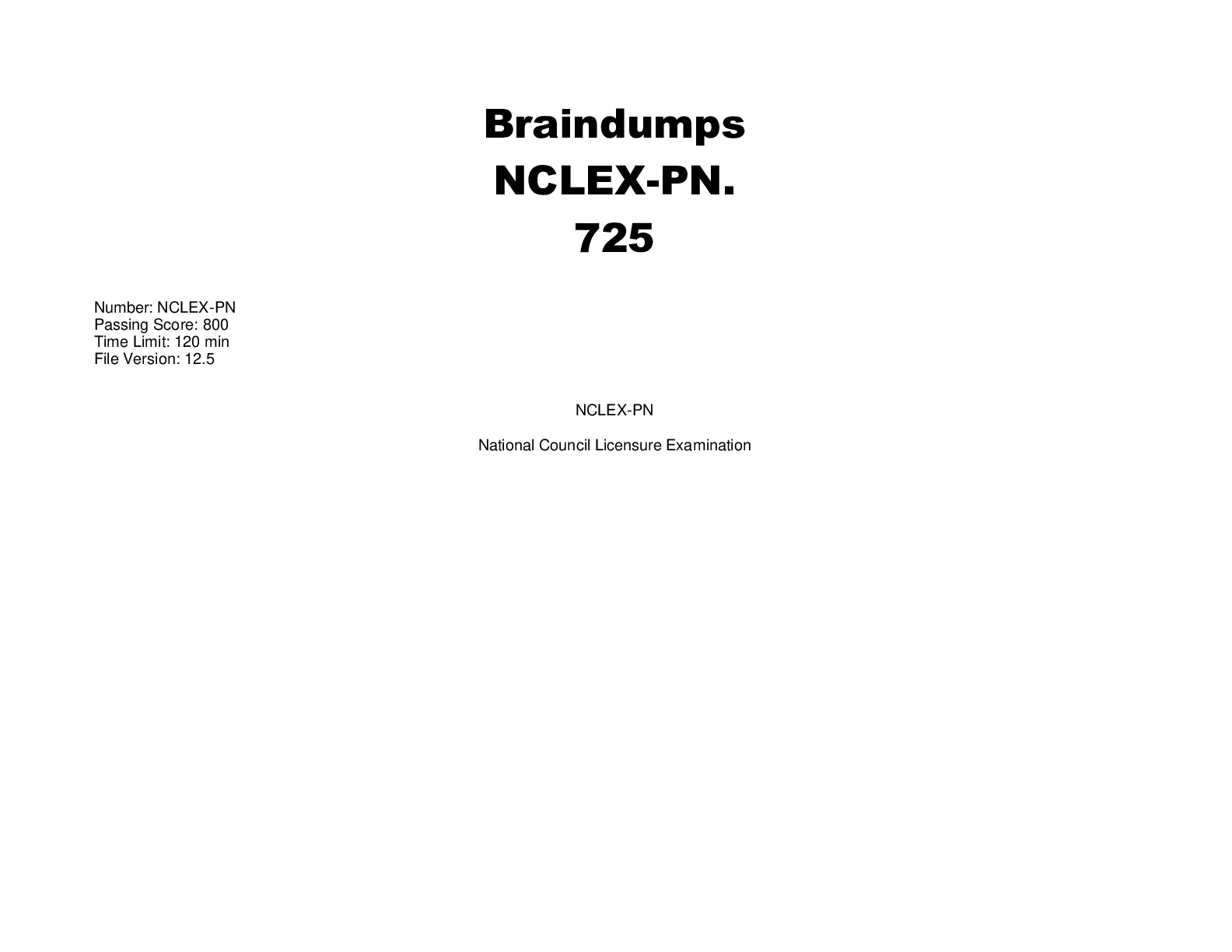
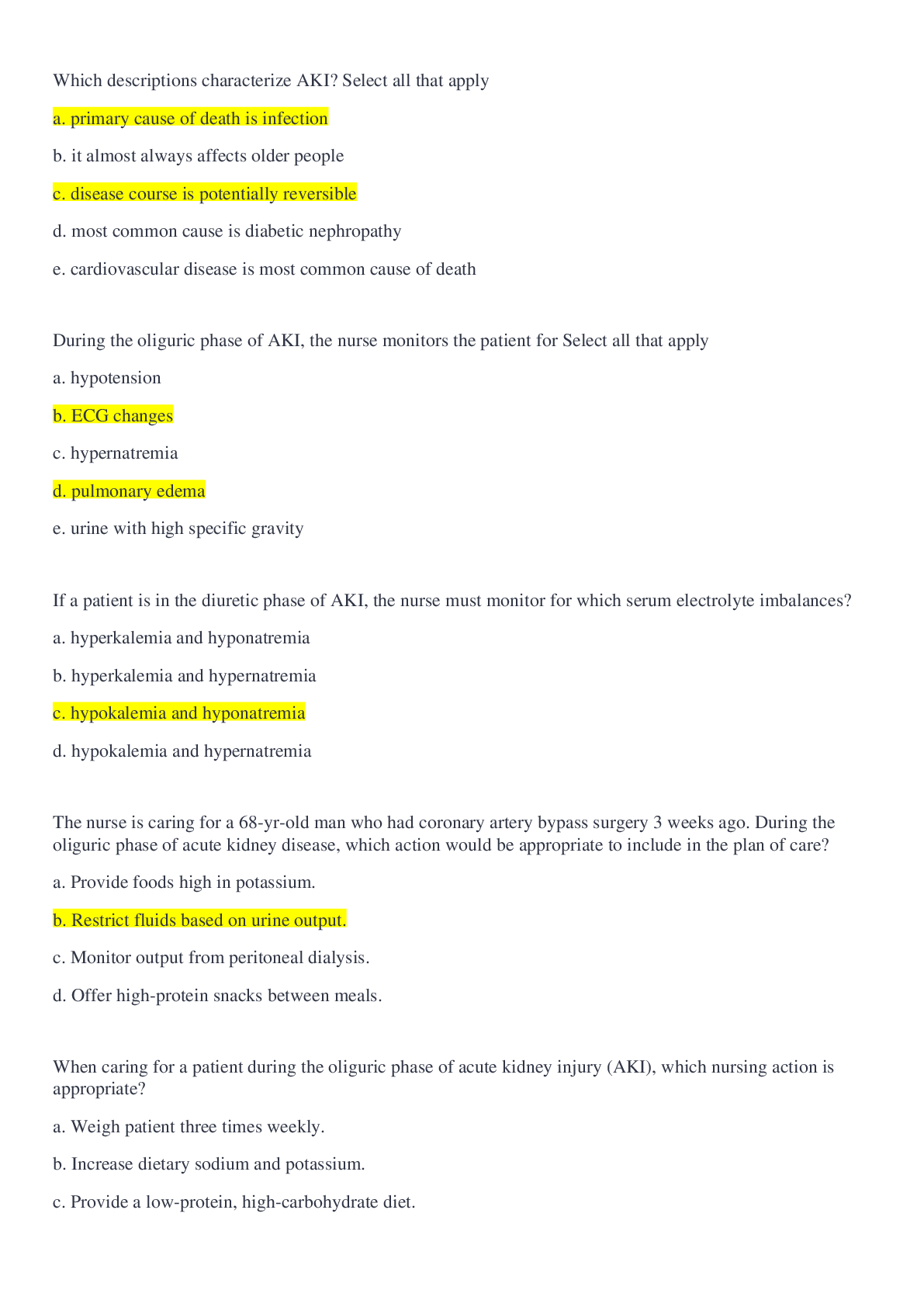

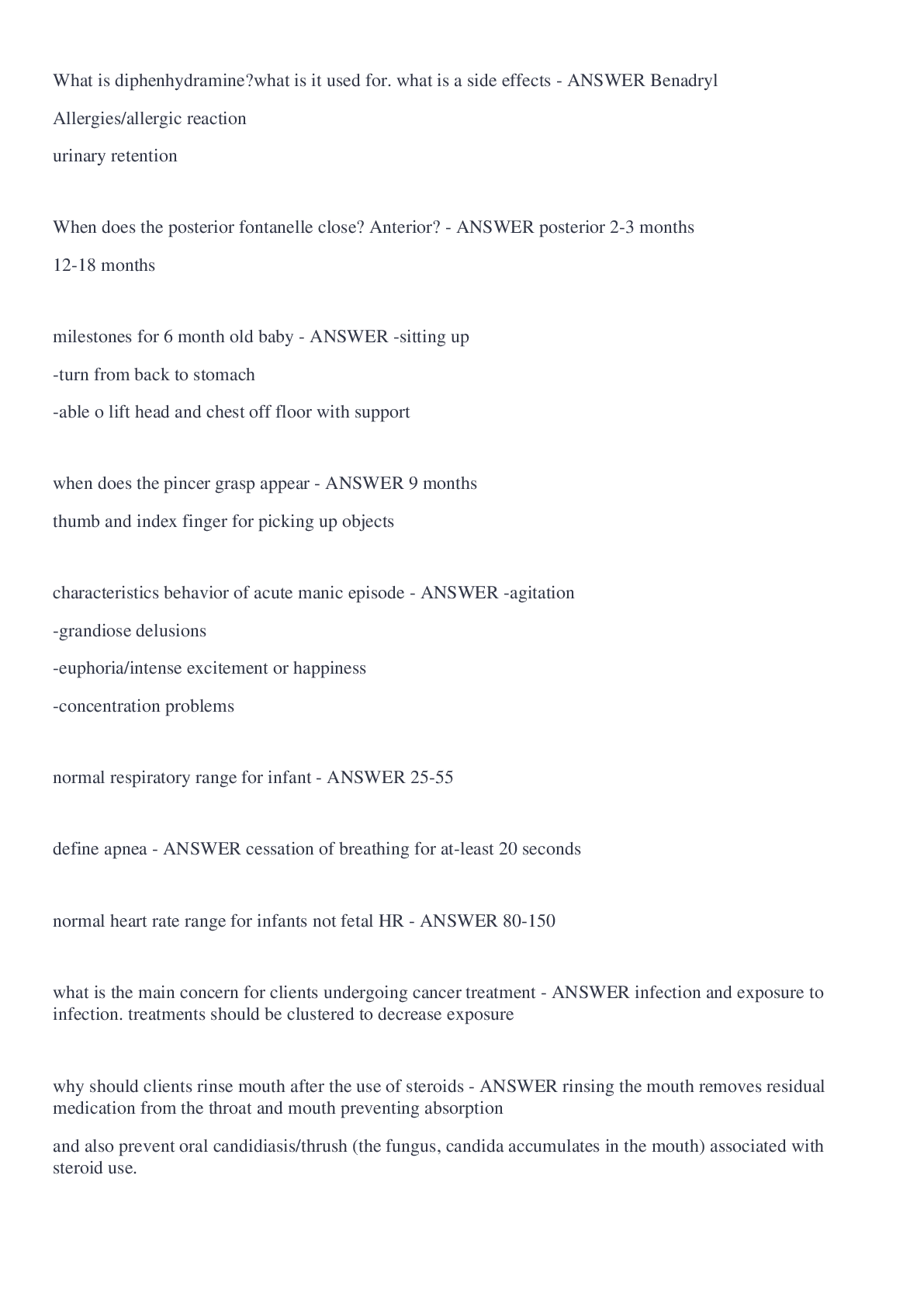
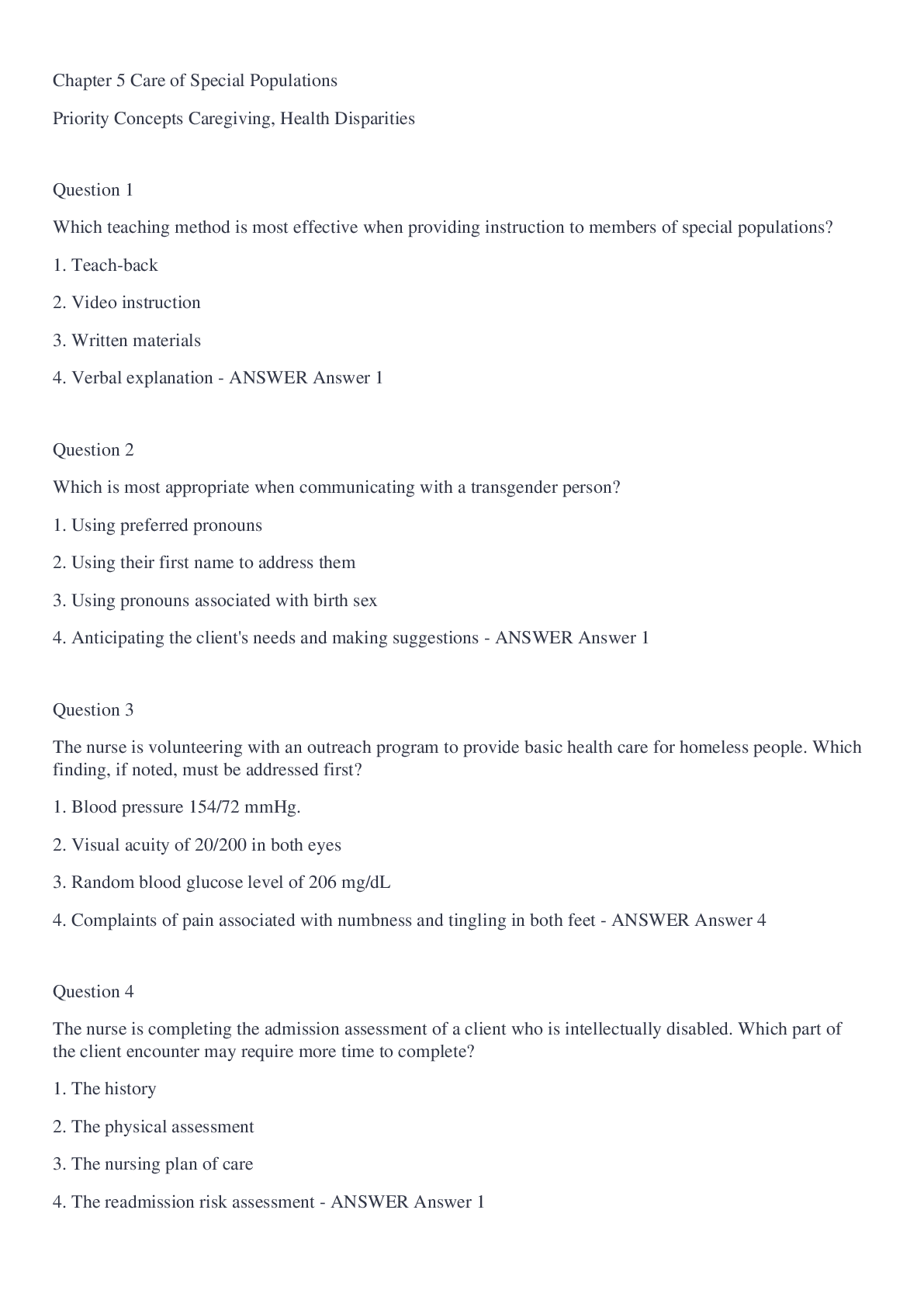

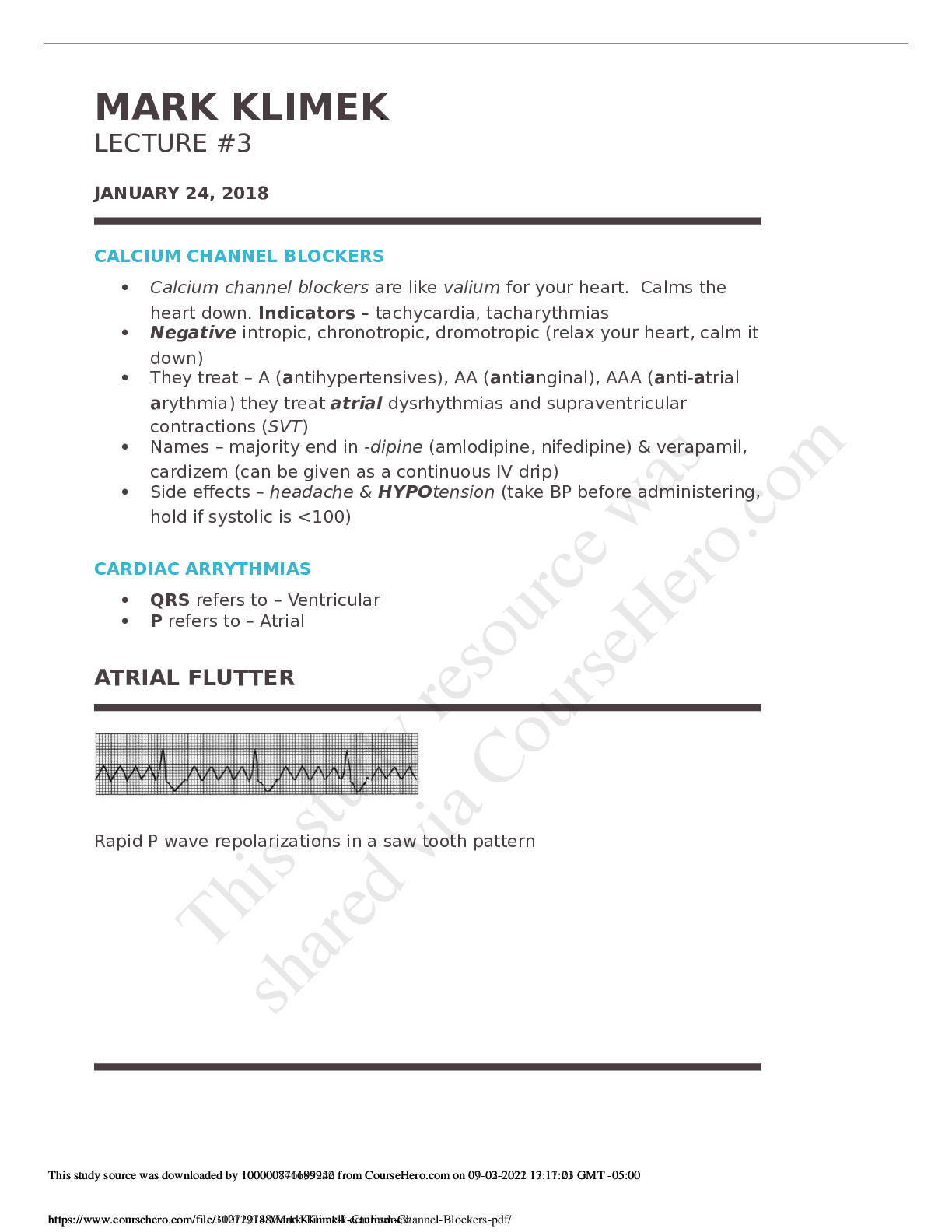

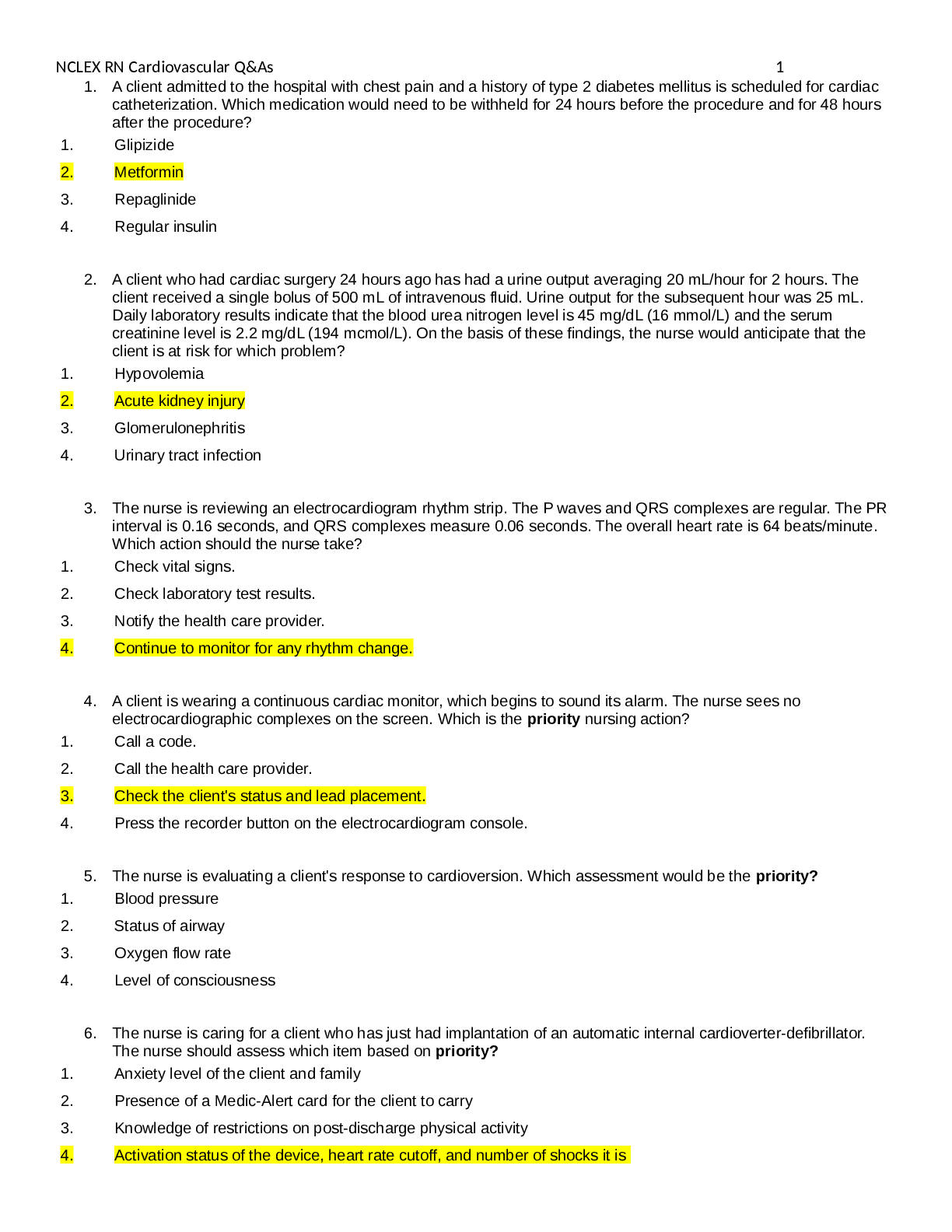
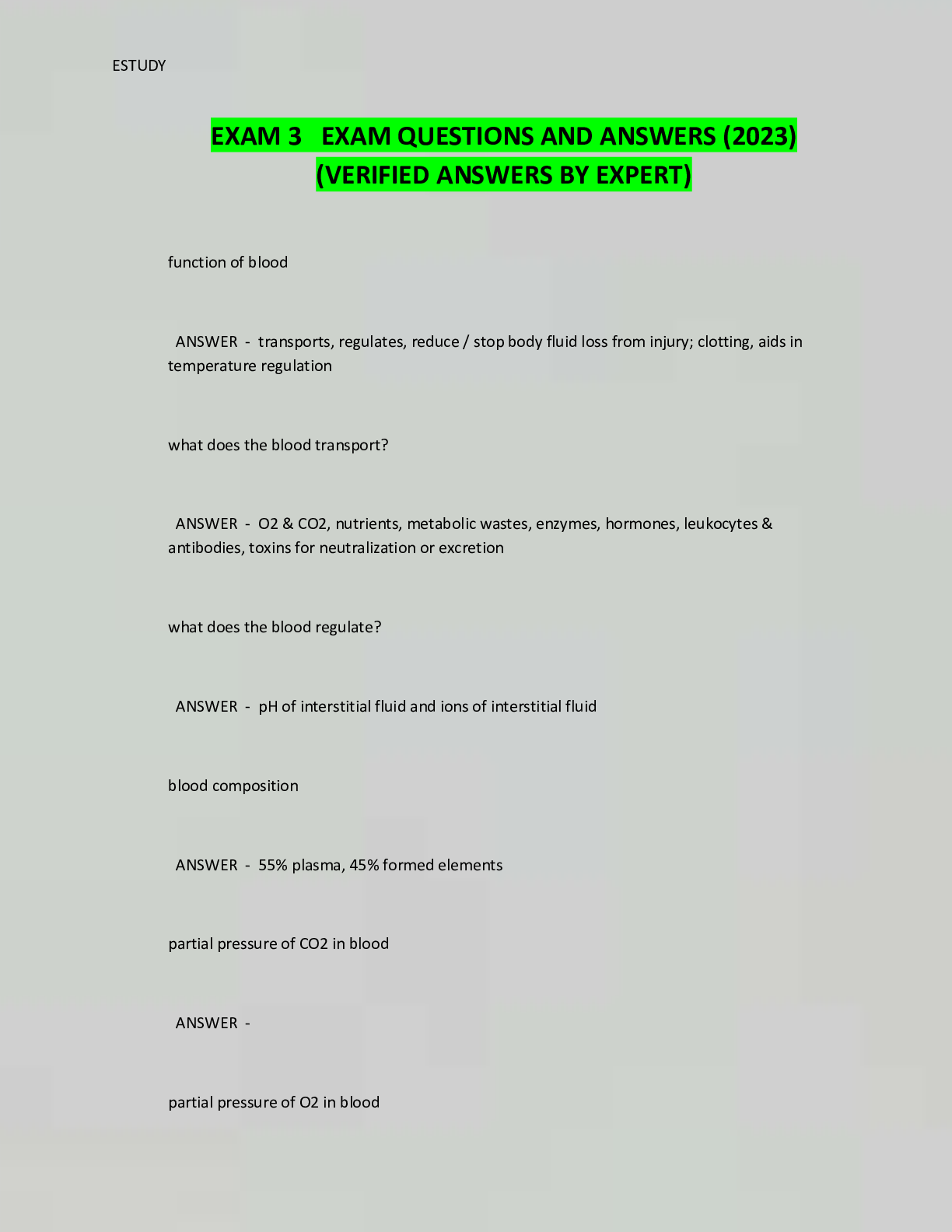
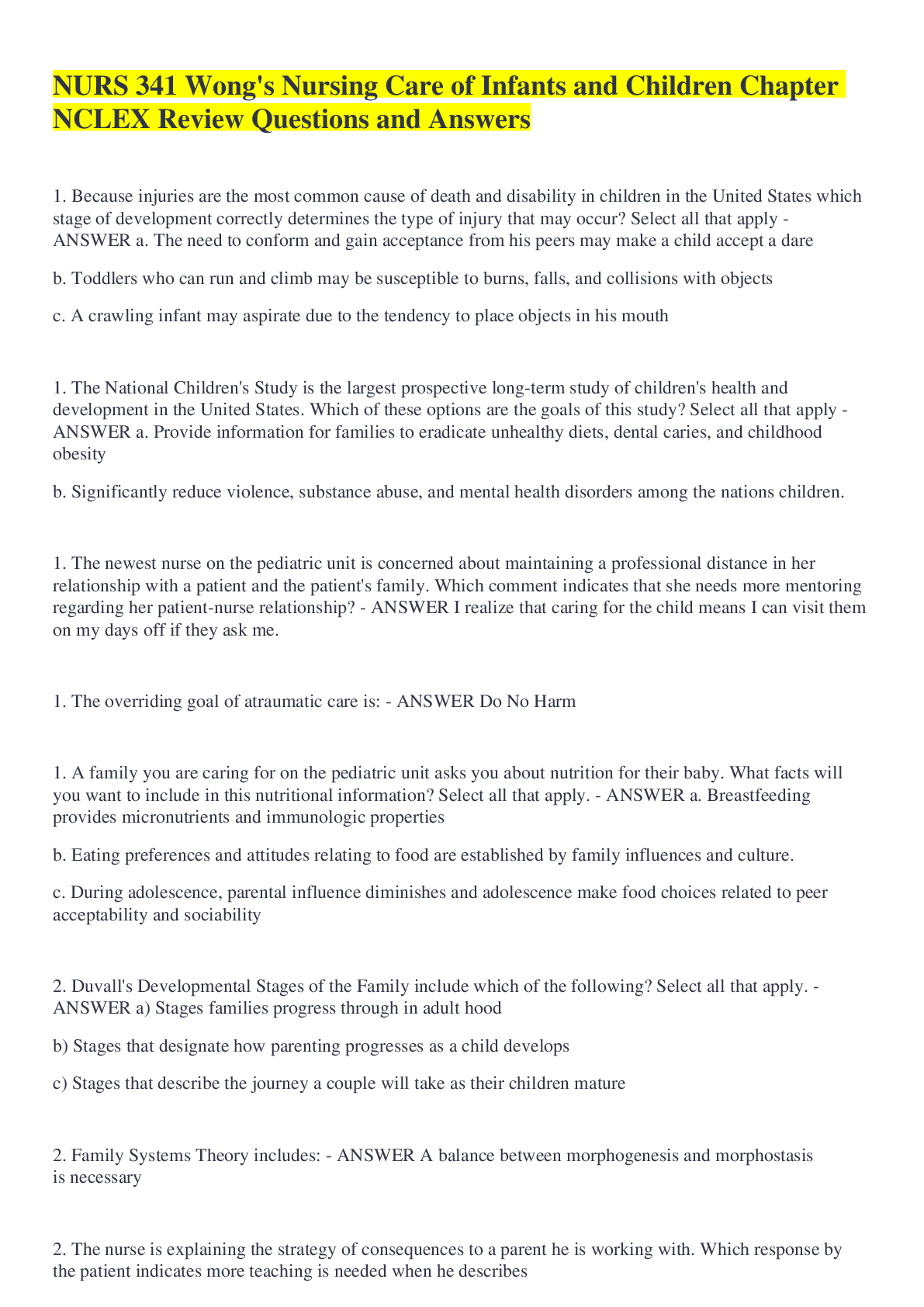
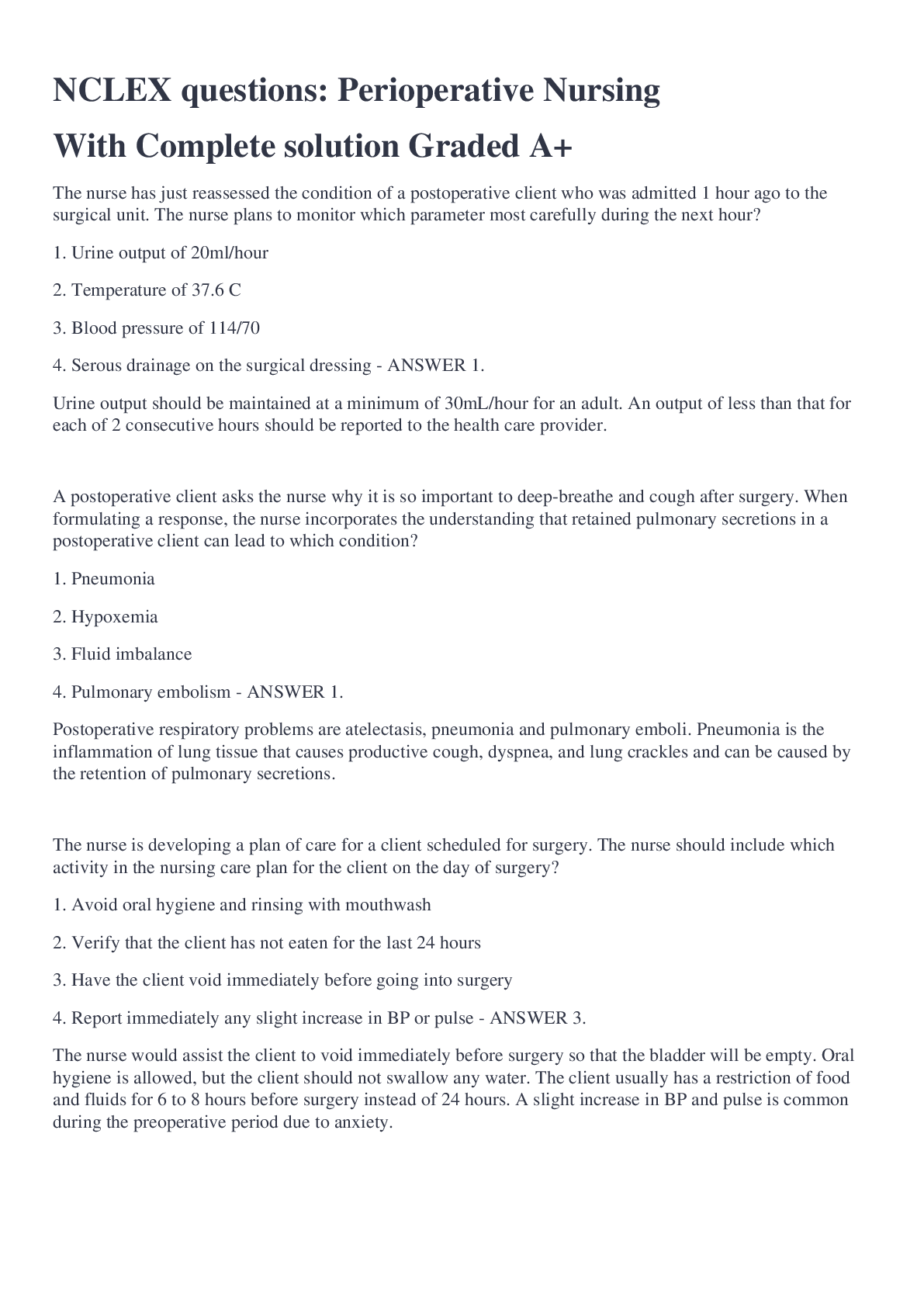

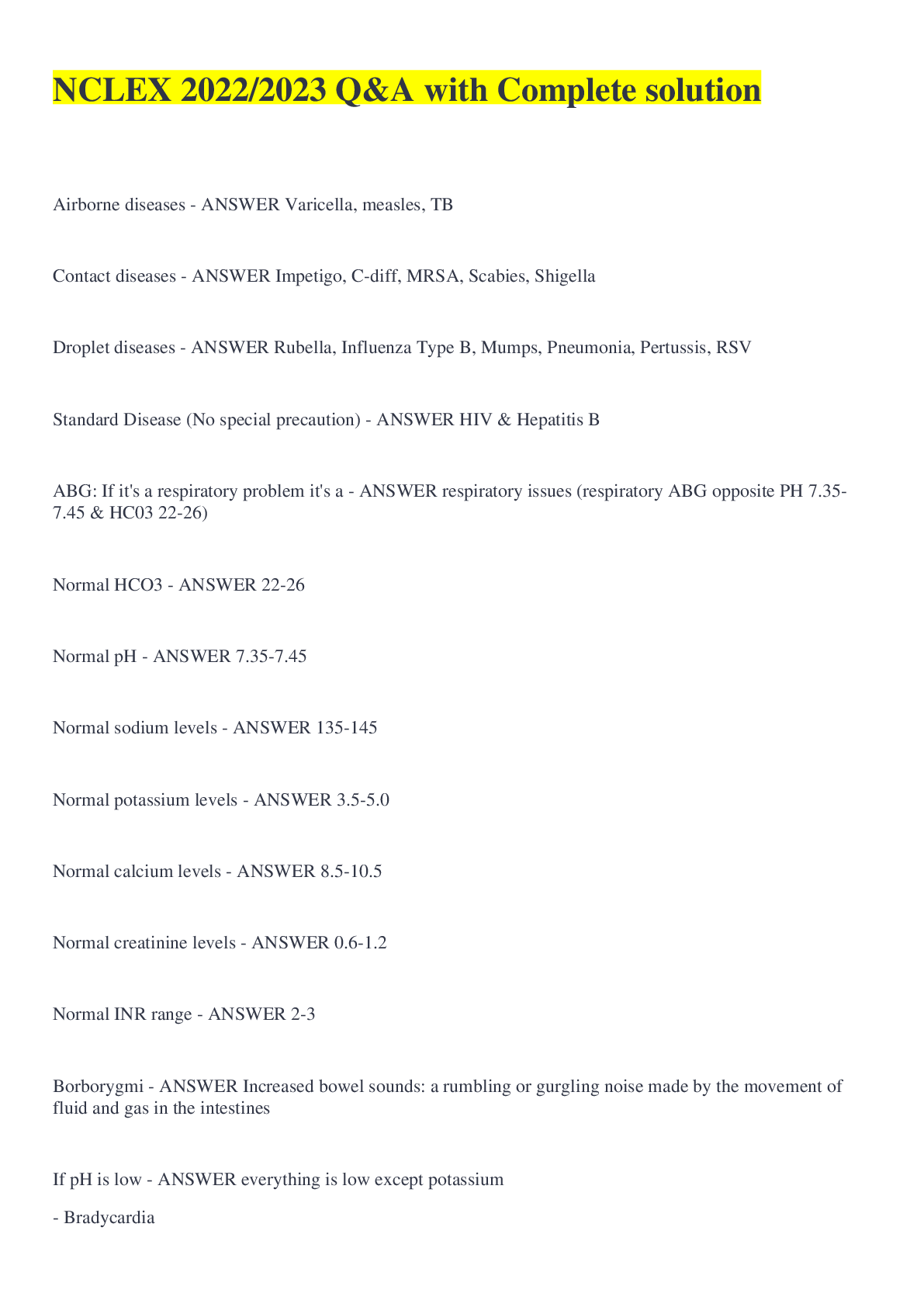
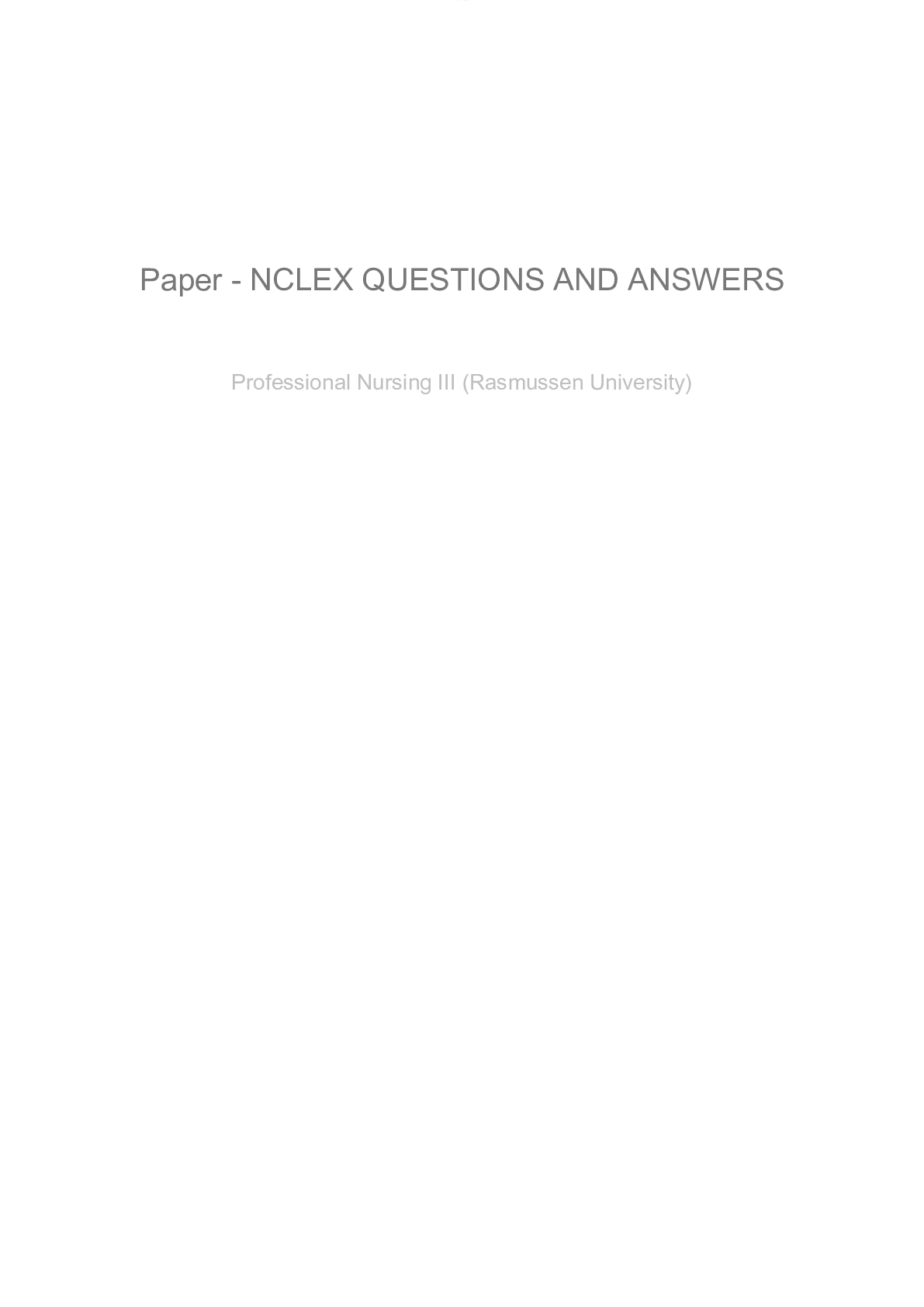
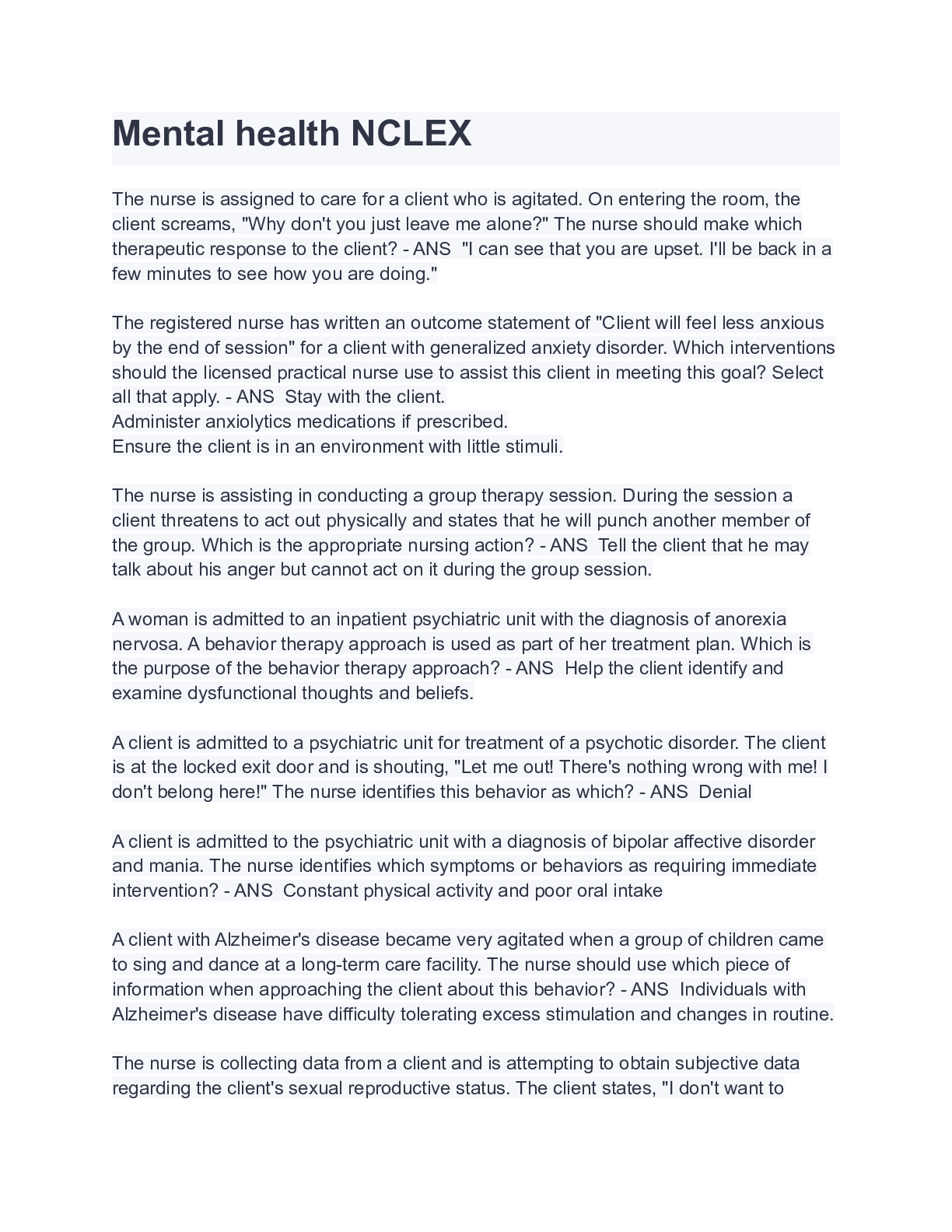

MENTAL HEALTH.png)
 (1).png)
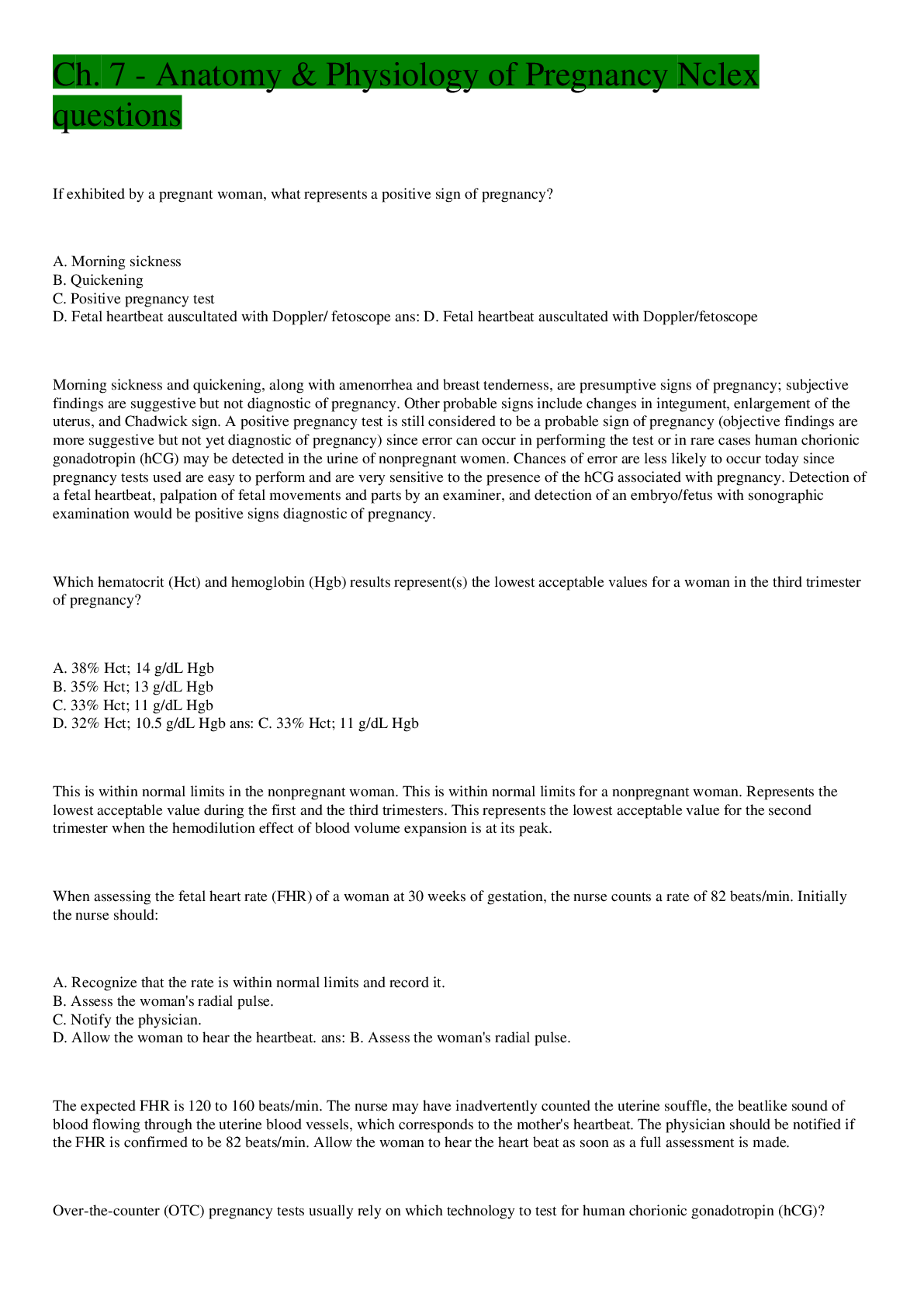
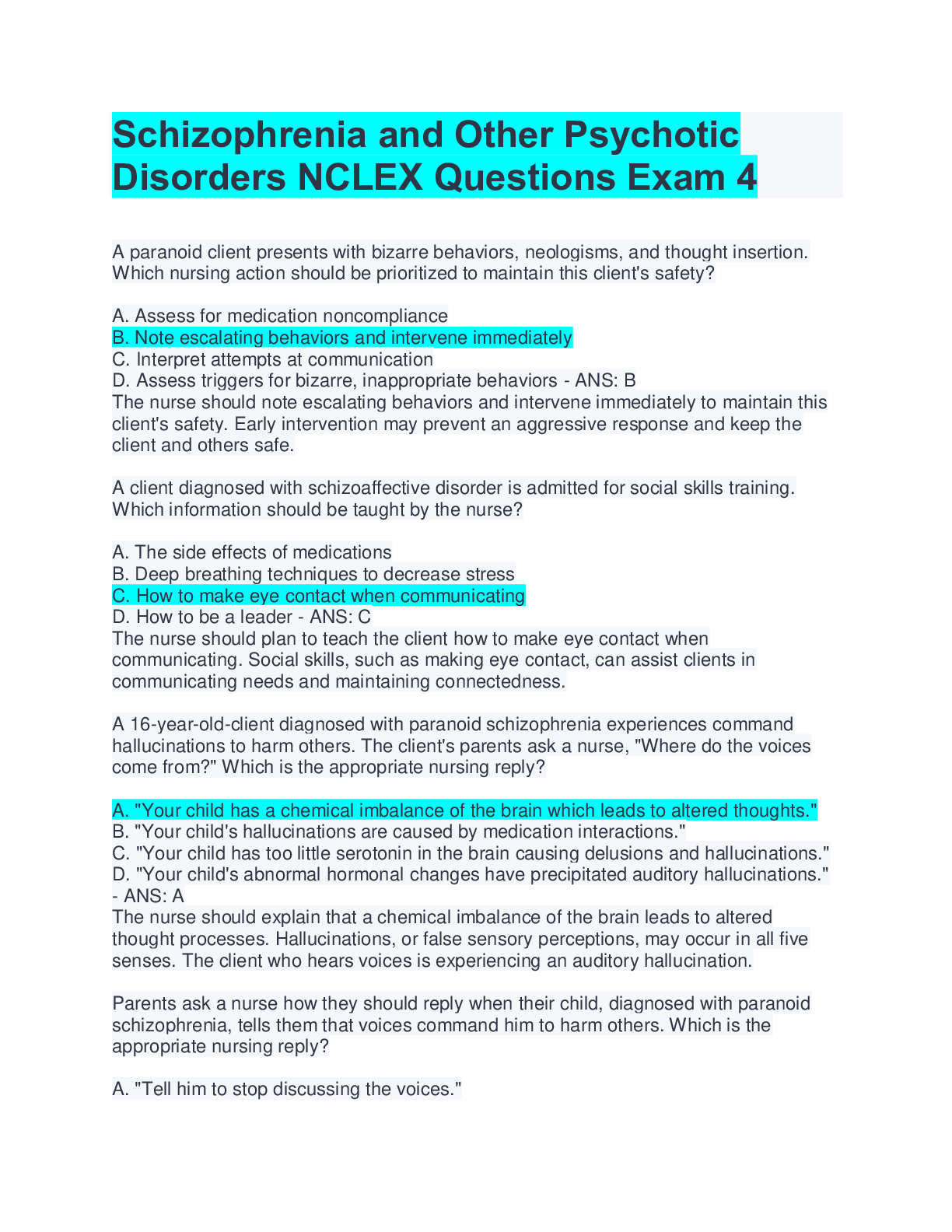
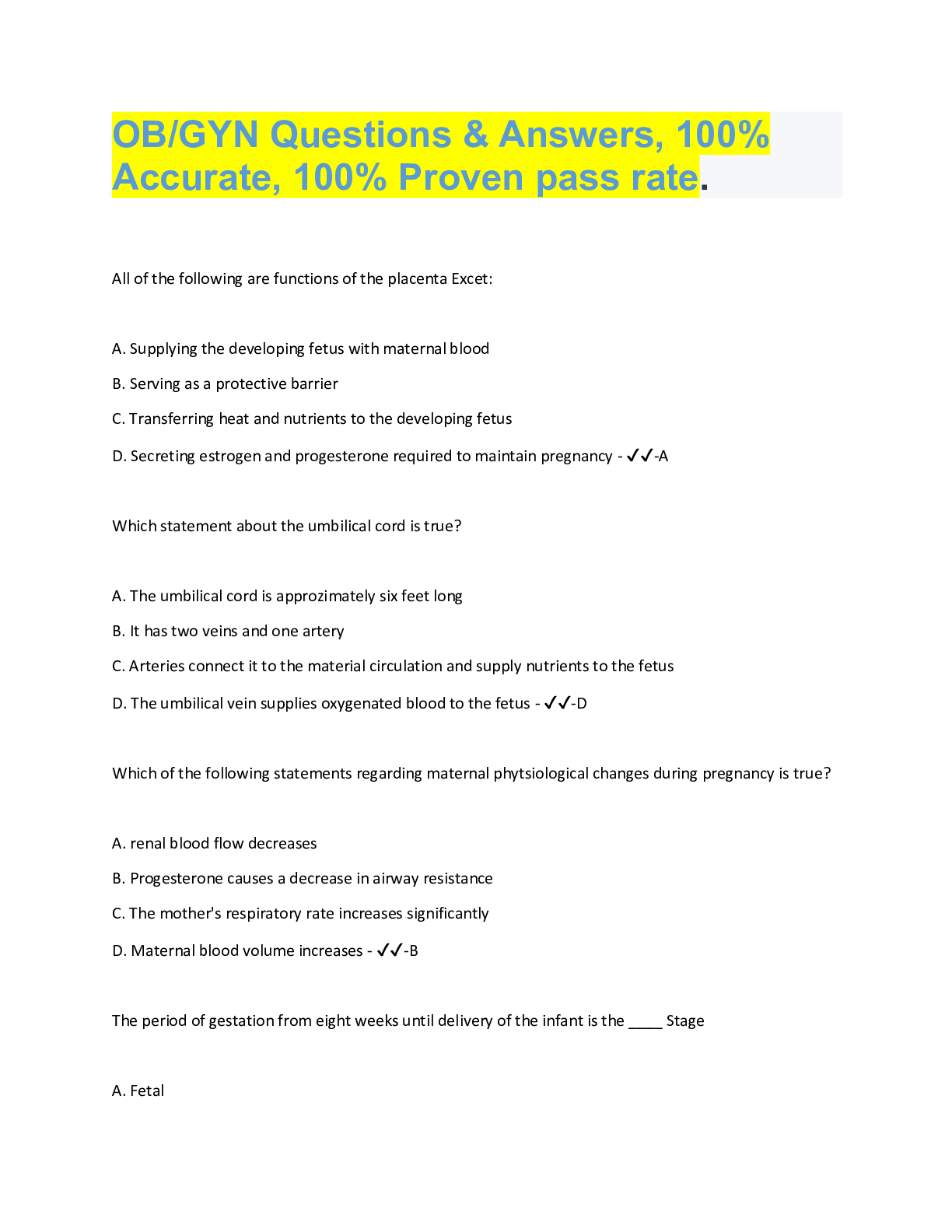
 (1).png)
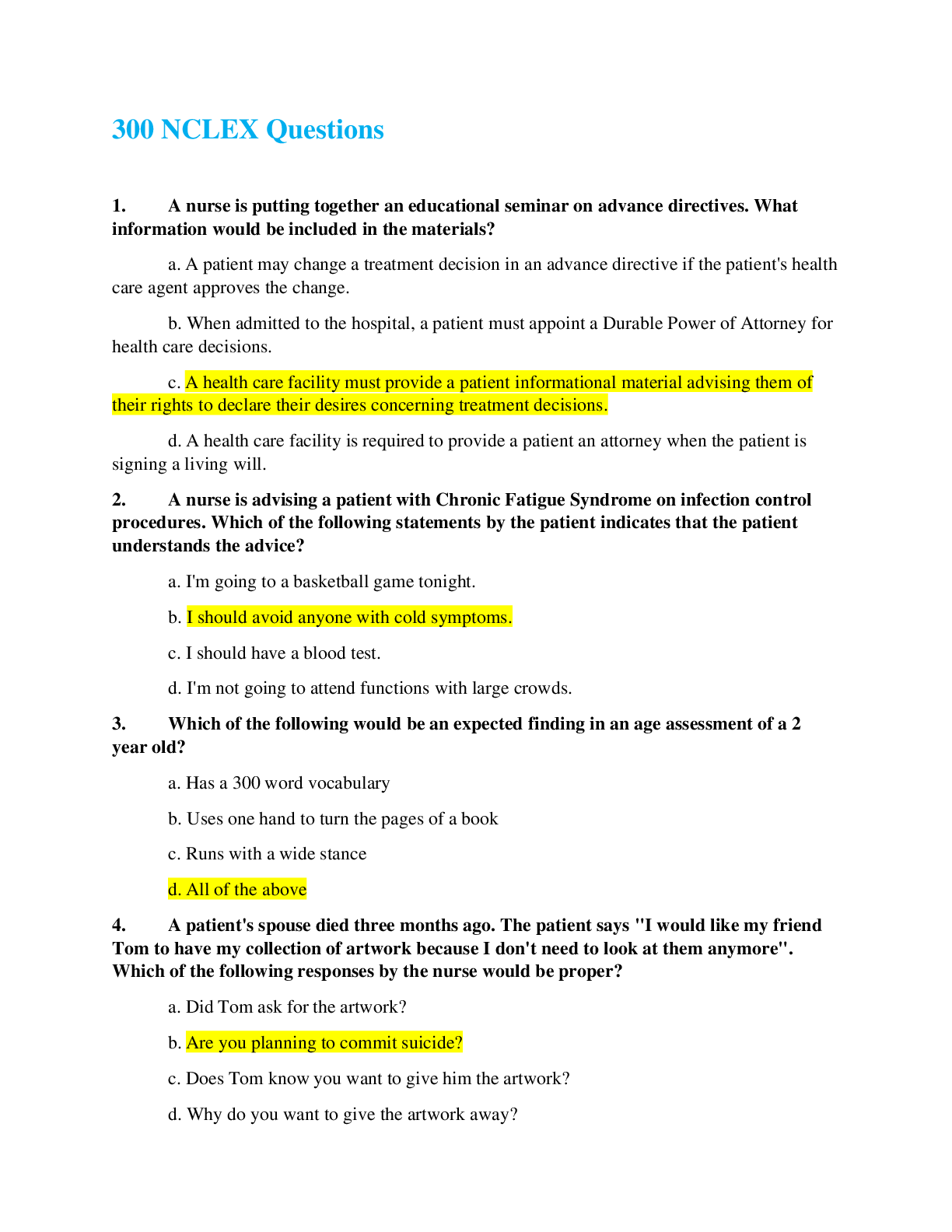

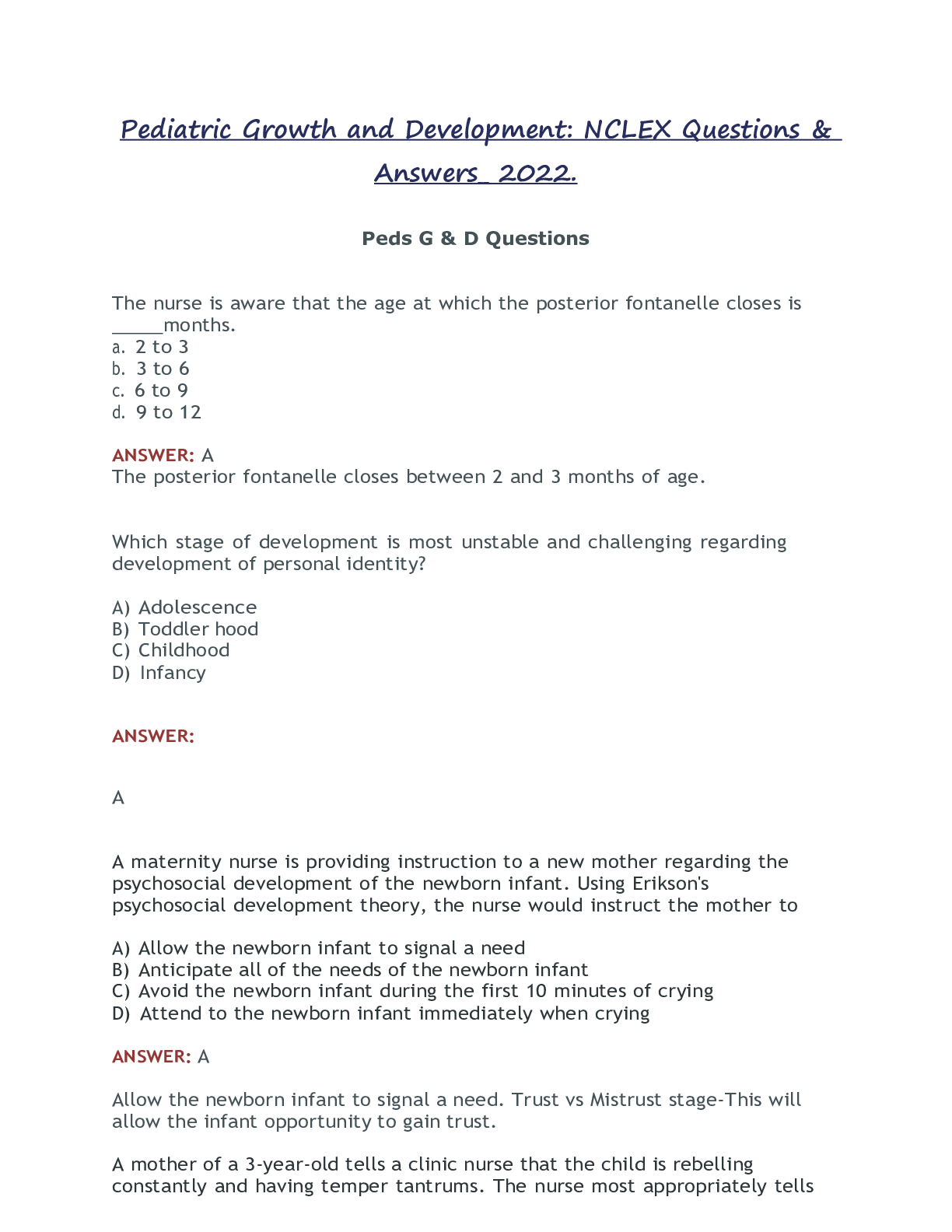
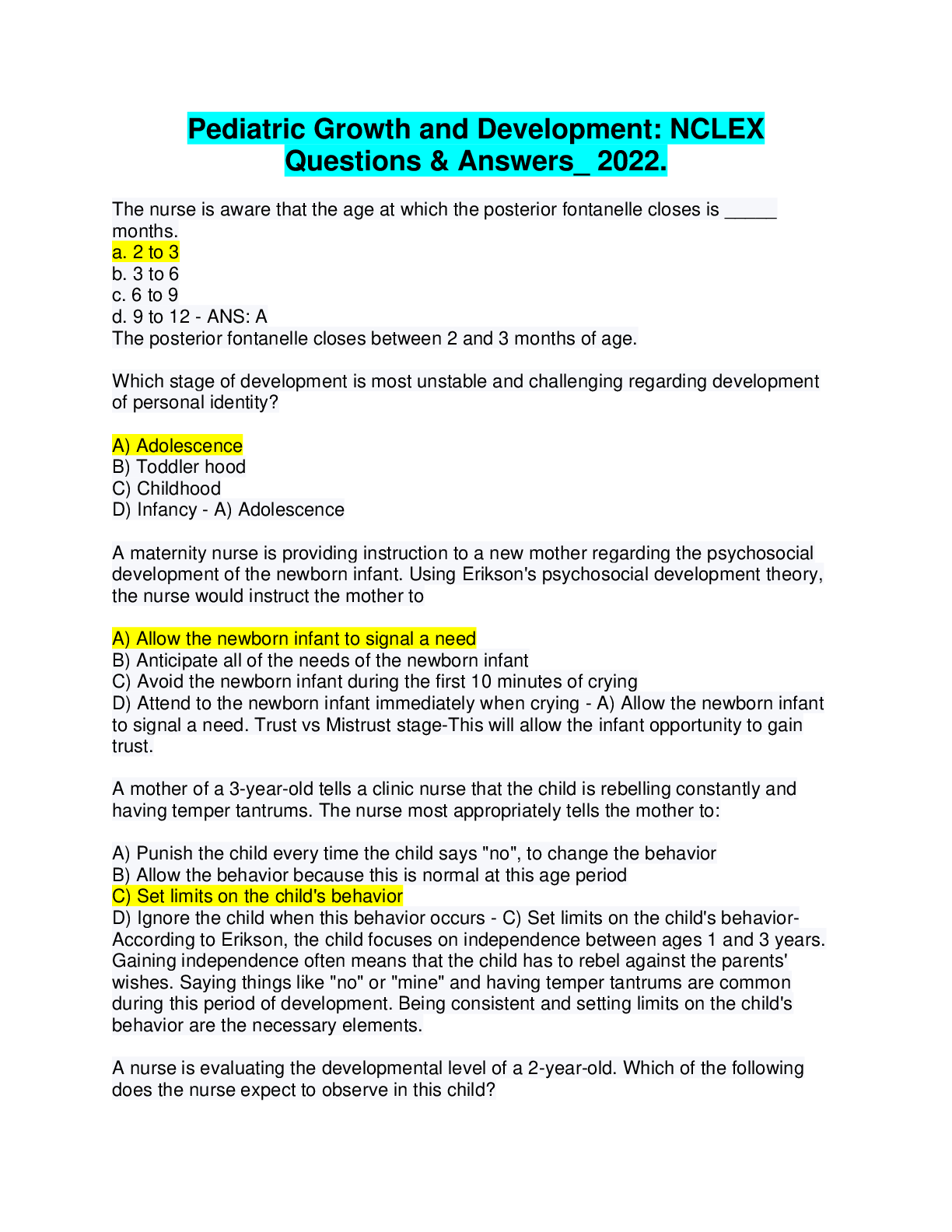
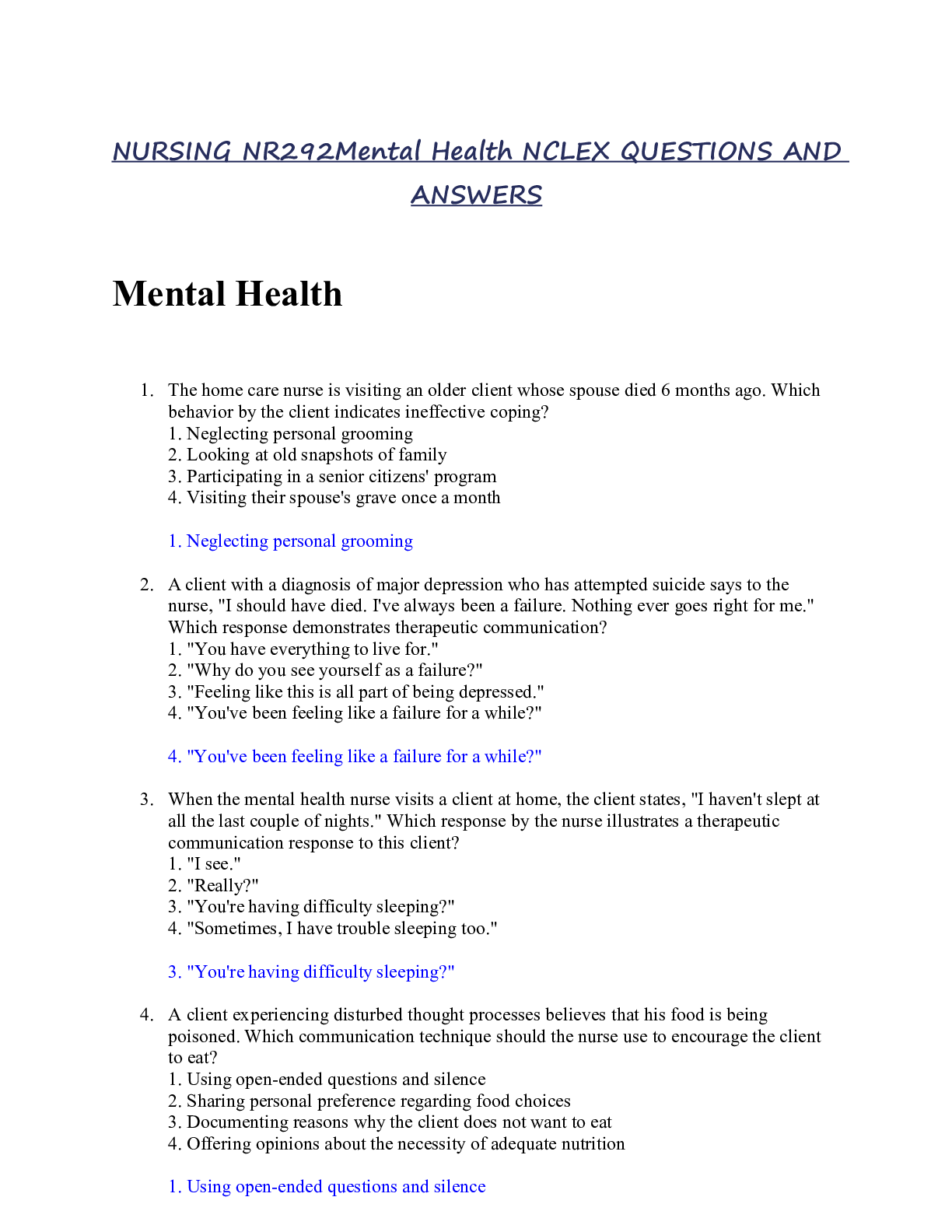
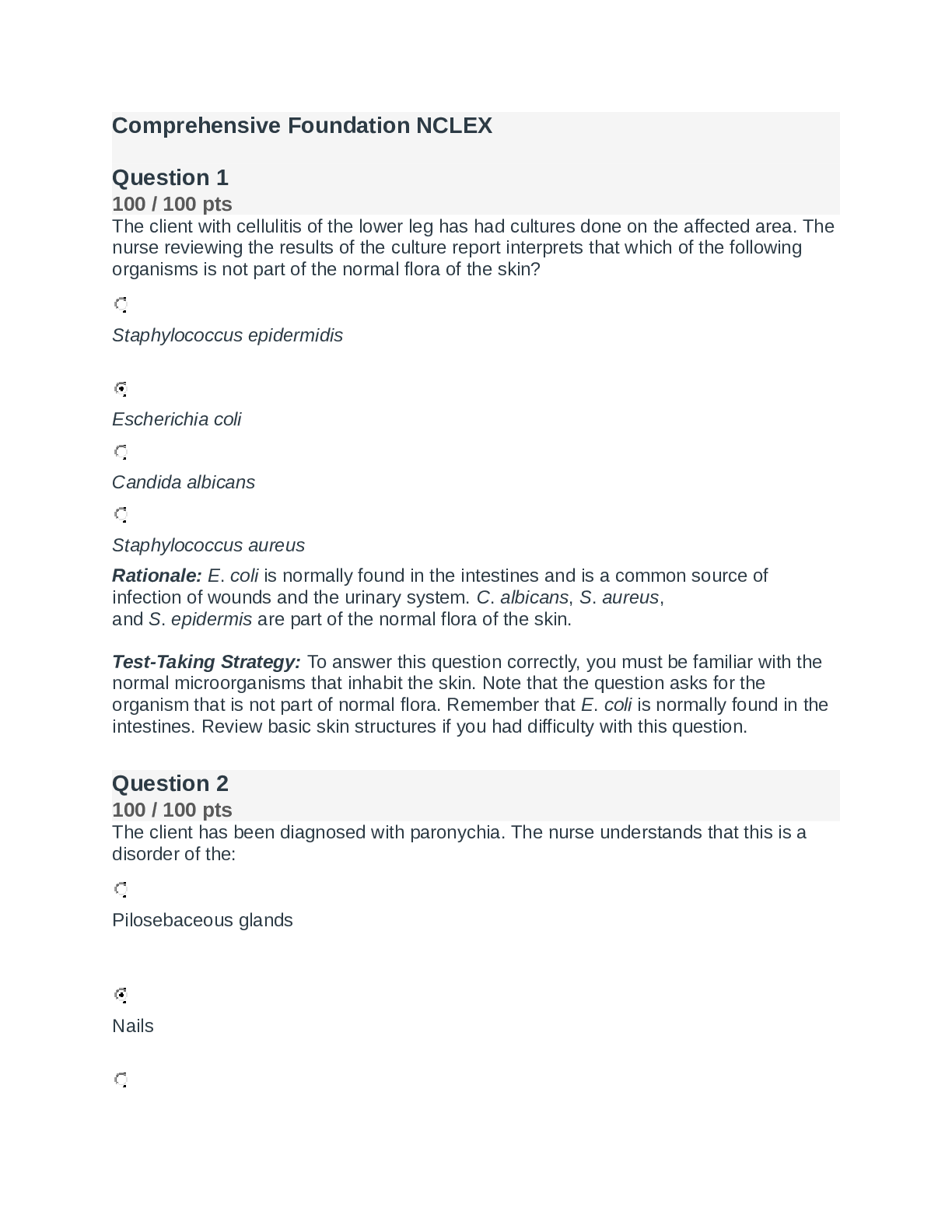
 (1).png)

 NCLEX Questions.png)

